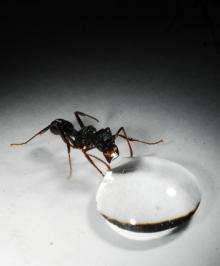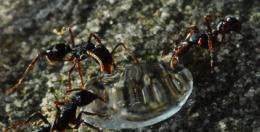The communal stomach of an ant colony

(PhysOrg.com) -- How do ant colonies manage the nutrients in their food? Audrey Dussutour from the Centre de recherche sur la cognition animale (CNRS/Université Paul Sabatier) and Steve Simpson from Sydney University have shown that an ant colony functions like a “collective mouth and gut”. The members of a colony are capable of dealing with the nutritional needs of their social structure by sharing tasks (foraging, digestion and excretion). The results of this study were published in Current Biology on 12 May 2009.
In an ants' nest, food is brought home by only 10% of the colony members - the foragers. This food is then regurgitated and shared among all the ants in the colony. Nutritional needs differ, however, between the young (larvae) and adults of the colony.
Audrey Dussutour and Steve Simpson have recently shown that the larvae, which cannot move or leave the nest, are capable of communicating their nutritional needs to forager ants, who adapt their gathering strategy accordingly. These researchers provided sugar- or protein-rich foods for ant colonies with and without larvae, and observed that ant behaviour differed. When a colony had larvae, high protein foods were preferentially gathered that could sustain larval growth. Inversely, when there were no larvae, the ants preferentially gathered sugar-rich foods.

In a second experiment, the researchers showed that sugar is the key nutrient regulating gathering in ants. Provided with a range of food containing varying proportions of protein and sugar, foragers are capable of harvesting the same quantity of sugar. These researchers also observed that when the food was rich in protein and poor in sugar, the excess of proteins was ejected from the nest. Ants are therefore capable of extracting sugar from food and regurgitating protein in the form of waste pellets.
However, despite this food manipulation, the colonies reared with protein-rich food had extremely high mortality due to protein toxicity and suffered losses of up to 75%. In comparison, the ant colonies reared on food of lower protein content lost less than 5% of their numbers. The scientists noticed that the mortality was lower in colonies with larvae.
They demonstrated that the ants in these colonies managed to partially escape the toxic effects of proteins by giving the work of nutrient processing to the larvae, which are better equipped for protein digestion. The researchers also confirmed the highly toxic effect of protein-rich food on ants, as they had previously demonstrated in fruit flies.
More information: Communal nutrition in ants, Audrey Dussutour, Stephen J. Simpson, Current Biology, 12 May 2009
Provided by Laboratoire CNRS EN LUTTE- Physique et Mecanique des Miliieux Heterogeneous (news : web)



















